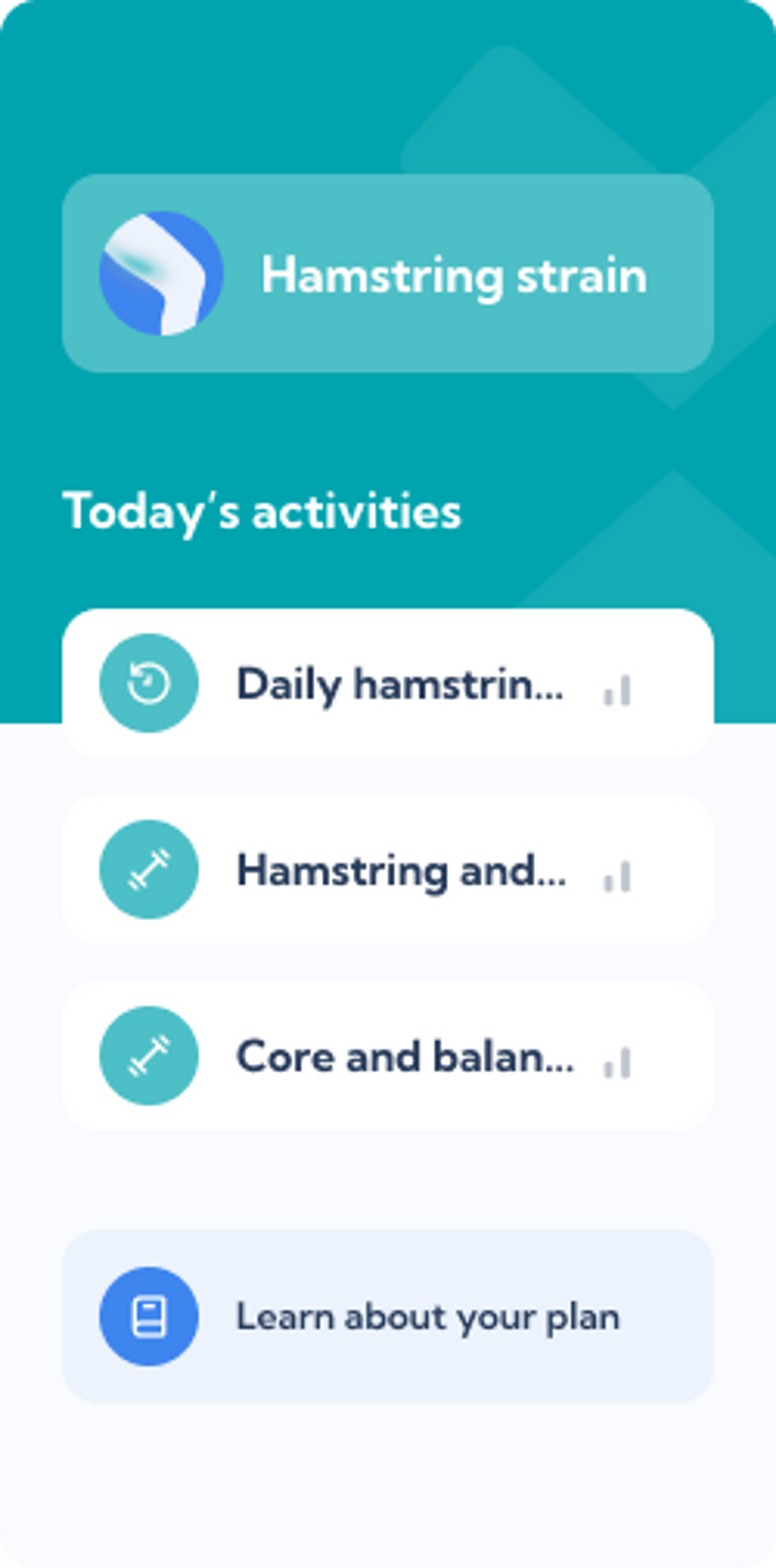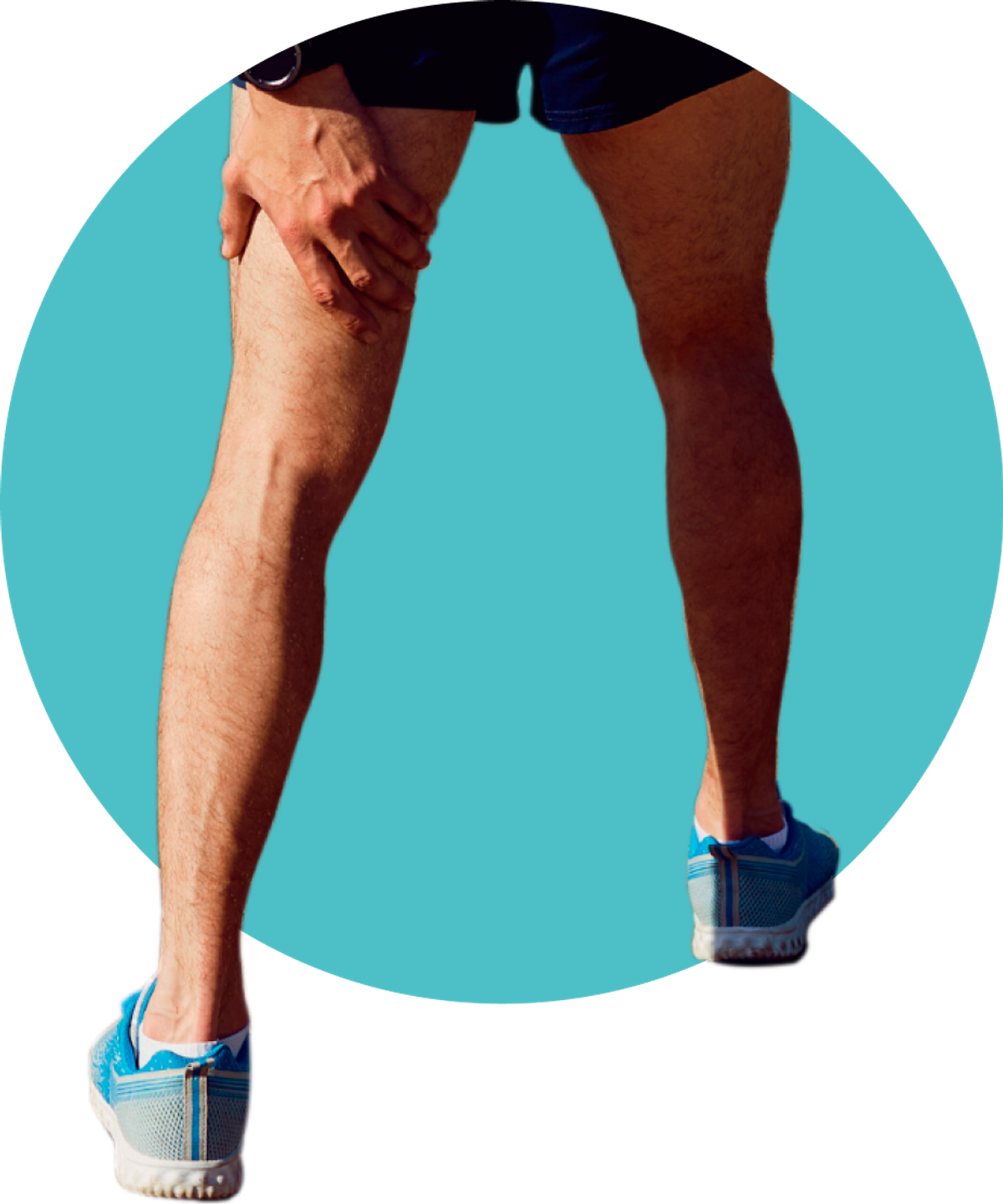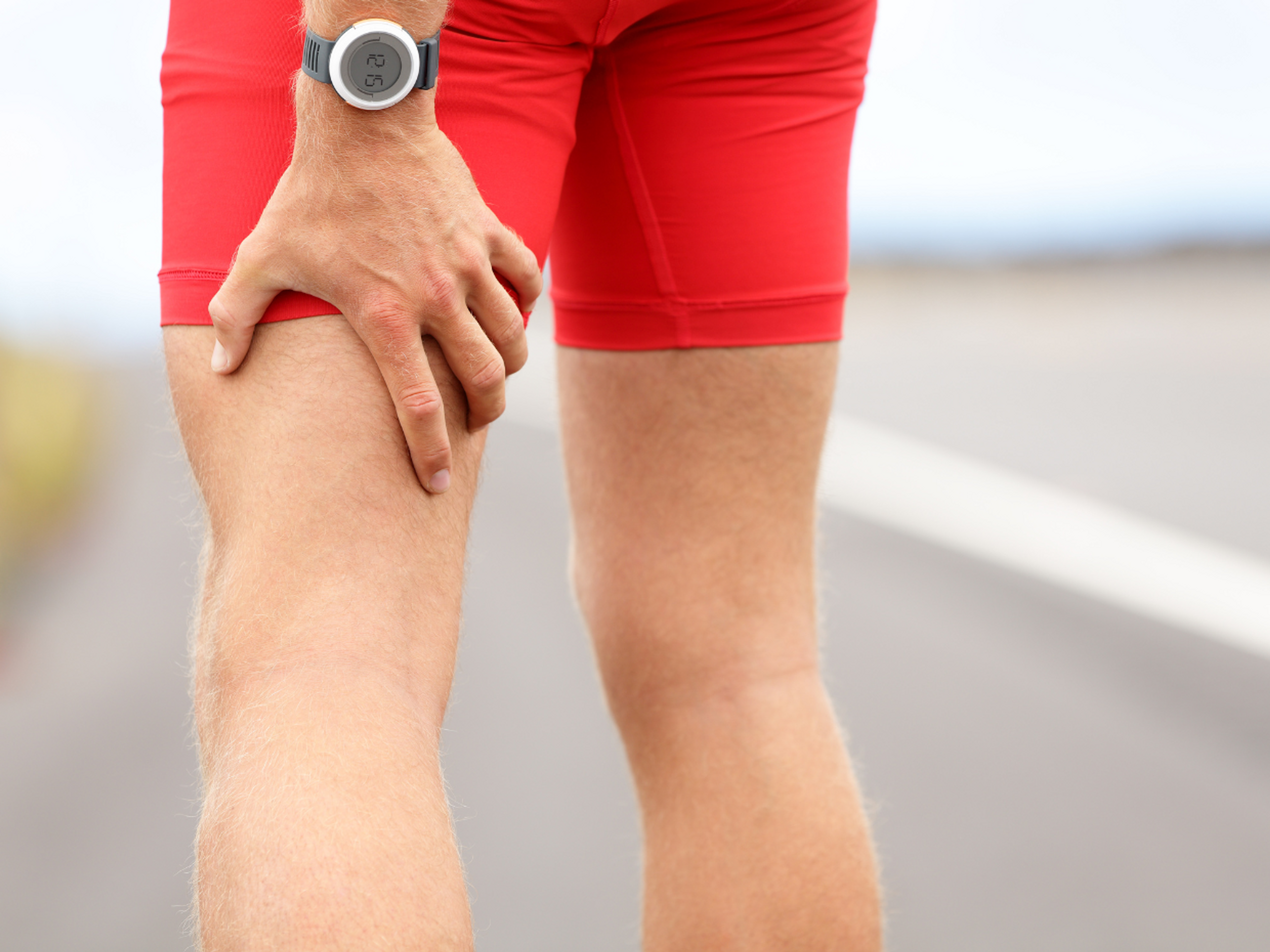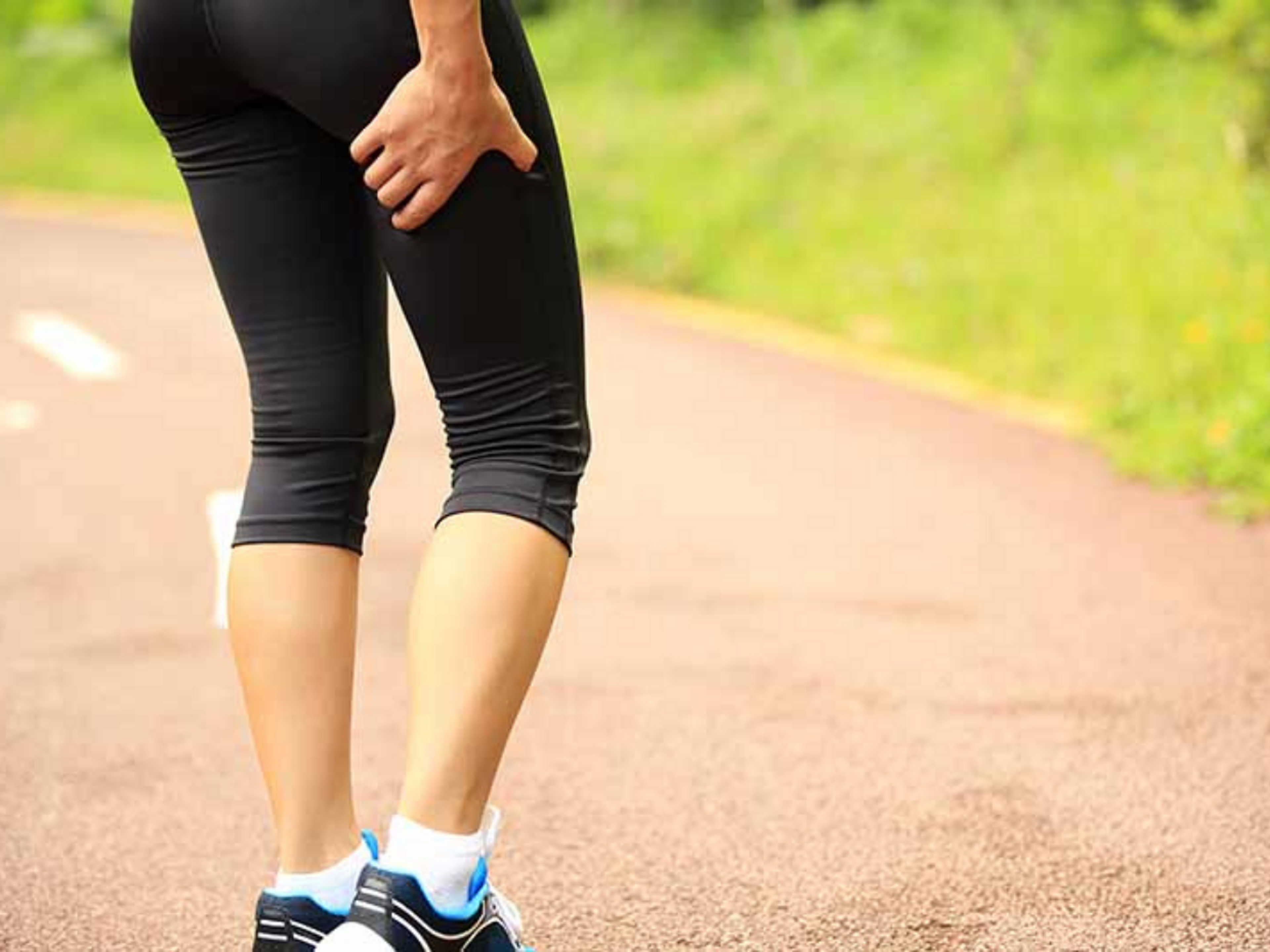Hamstring strain treatment plan
- The hamstring strain treatment plan contains evidence-based video exercises with clear guidance on reps, sets and frequency.
- The app adapts the program according to your feedback and specific needs.
- In order to regain full strength the workout intensities have to increase as your hamstring heals.
- The app ensures that you progress at the correct time by setting you clear targets for each stage.
- Certified as medical device
- Based on latest research
- Built by sports physios
- 1Acute stageThe first 72 hours: Aim to allow your hamstring injury to settle and limit the amount of swelling and internal bleeding.
- 2Sub-acute stageGentle strength training for your hamstrings. Carefully ease into the exercises to activate your hamstrings and build strength in low-load positions during this stage.
- 3Remodelling stageRestore the flexibility in your hamstrings and build the strength needed for easy running. You’ll also continue improving the strength & control in your core muscles.
- Best recovery app for sport injuries I have ever used.Bondu47 - App Store2023-03-03
- I have a hamstring injury and this app provided me with a recovery plan. I started following for about a week and already I am feeling better! The exercises are very detailed both with video and text. In the text instructions, you can find tips about how to do the exercises. Each day the exercises are tailored to your load. I definitely recommend it to anyone!Postavarul – App Store2022-04-30
The hamstring muscles are a group of 3 muscles located at the back of your thigh. They all originate from your sit-bone and attach to the back and sides of your knee. Two of them run along the inner part (medial) of the back of your thigh, while the third runs more to the outside (lateral).
When you tear or strain a hamstring muscle, you usually feel a sudden sharp pain in the back of your thigh. This sensation can make you quickly pull your leg up into a shortened position, to try to protect it.
If it’s a very mild strain, you may be able to continue your activity, but at a slower pace. However, if it’s a more severe strain, you will likely have to walk slower and with very short strides.
The severity of the symptoms that you experience in the next few days will depend on how badly you’ve injured your hamstring – they can include:
- Moderate to severe pain in the area of the tear. It is common for the rest of the muscle to feel tight and stiff, and it may be painful to sit on it.
- It will likely be painful to walk or take long strides.
- It will be painful to stretch your hamstrings, and in severe cases, you may be unable to fully straighten your knee for a few days.
- Running will hurt.
- It will be painful to contract your hamstring against resistance.
- You may see some swelling and bruising, but this is not present in all cases. It may even take a few days to show. In addition, the bruise often shows up much lower than the tear because gravity pulls the fluid in the injured tissues downwards.
Most hamstring injuries can be treated at home using a conservative exercise-based treatment plan outlined in the app.
You should consider seeing a medical practitioner if you have any concerns about your injury, particularly if:
- You heard or felt a pop when you injured your leg, especially if it was close to your sit-bone. It can indicate a more severe tear involving the hamstring tendon, and you may need a special treatment plan for it.
- You think it’s a severe injury, and there is a lot of swelling and bruising.
- Any part of your leg (thigh, calf, or foot) is very swollen, red, hot to touch, or throbs with pain. These can indicate a blood clot, and you should investigate it as soon as possible.
- You have pain at night that keeps you awake or interrupts your sleep.
- You feel pins and needles or tingling in your leg, indicating a nerve injury. In which case, our treatment plan may not be well-suited to you.
- Your symptoms are getting worse.
- Your injury is not healing as expected (see the anticipated healing times below).
Against widespread belief, tight or inflexible hamstrings are not the leading cause of hamstring strains.
Of course, a good range of motion is desirable, but you don’t need super flexibility to stay injury-free. Instead, research has identified the following hamstring injury risk factors:
- Increased sprint/intense running: If you do a lot of high-intensity training, it causes your muscles to tire and strain more easily.
- Fatigue: You are more likely to tear a hamstring towards the end of a high-level running or training session when your muscles are tired.
- Sudden increases in running intensities and volume don’t allow your muscles enough time to adapt and grow stronger, making them vulnerable to injury.
- Weak hamstring muscles are prone to strain under forceful contractions during sprinting, hill running, jumping, or kicking.
- Previous hamstring, calf, ankle, or knee strains or injuries predispose you to a hamstring strain, even more, if you haven’t fully recovered from the initial injury.
- Reduced strength and control in your lower back muscles and core can cause hamstring overload.
- Older age also increases your risk of developing hamstring strains, as aging is associated with muscle and strength loss. Therefore, it’s essential to keep up your regular strength training.
Treatment
Straining or tearing a hamstring muscle involves an injury to the muscle where some muscle fibers or cells pull apart. For your muscle to recover correctly, it must go through a natural three-stage healing process:
- First, your body gets rid of the injured cells through an inflammatory process (Stage 1).
- Next, your body will create new muscle cells to replace the damaged ones (Stage 2).
- Finally, your body will strengthen the new muscle cells by doing the right exercises which stimulate this process (Stage 3).
Our treatment plan aligns with this natural healing process. The graduated strength exercises signal the body to build and strengthen new muscle cells.
Because we all heal at different rates, it is essential to progress through the exercise levels and stages at your own pace.
Healing time
To give you some guidance on how quickly you might recover from your strain, consider the following recovery times:
- A very mild hamstring strain usually heals within 15 to 21 days.
- More severe strains can take between 20 and 60 days to recover fully.
- If you have a very severe strain involving a large part of the muscle or the tendons, it can take 90 days or longer to recover fully.
- If you’ve neglected your hamstring strain for a while, tried to train on it, or reinjured it a few times, it may take several months to heal.
Prevention
Most hamstring strain prevention research is football-based, but some findings apply to all running sports. Universal elements to add into hamstring injury prevention programs:
- Eccentric hamstring strength training
- Balance and proprioception exercises
- Core strength and control work, as well as whole-body strengthening
- Race or match-day specific training, such as kicking, tackling, and sudden sharp sprinting, in addition, hill sprints gradually expose the hamstrings to higher-risk activities.
- Avoiding sudden increases in running volumes or intensity, allowing enough rest time to adapt and grow stronger
- Adequate warm-ups before training, in particular, before intense training sessions




